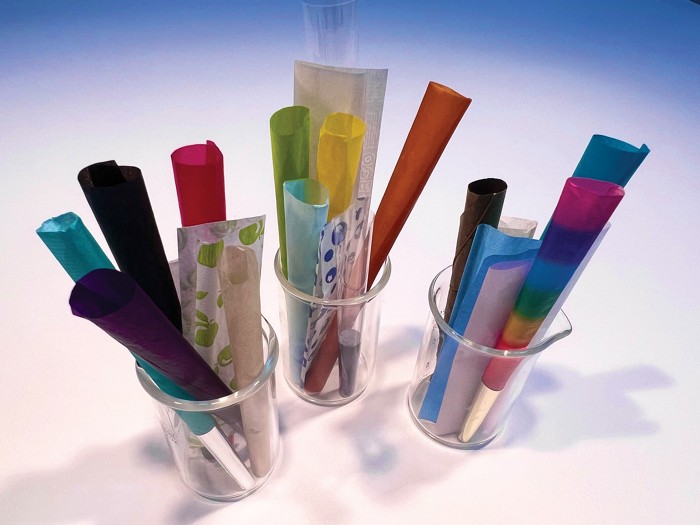Advertisement
Grab your lab coat. Let's get started
Welcome!
Welcome!
Create an account below to get 6 C&EN articles per month, receive newsletters and more - all free.
It seems this is your first time logging in online. Please enter the following information to continue.
As an ACS member you automatically get access to this site. All we need is few more details to create your reading experience.
Not you? Sign in with a different account.
Not you? Sign in with a different account.
ERROR 1
ERROR 1
ERROR 2
ERROR 2
ERROR 2
ERROR 2
ERROR 2
Password and Confirm password must match.
If you have an ACS member number, please enter it here so we can link this account to your membership. (optional)
ERROR 2
ACS values your privacy. By submitting your information, you are gaining access to C&EN and subscribing to our weekly newsletter. We use the information you provide to make your reading experience better, and we will never sell your data to third party members.
Consumer Safety
Cannabis rolling papers may be loaded with unsafe metals
Heavy users could be getting exposed to high levels of copper, chromium, and vanadium
by Carolyn Wilke, special to C&EN
April 23, 2024

Cannabis users may be inhaling unsafe levels of heavy metals as rolling papers burn, according to a new study (ACS Omega 2024, DOI: 10.1021/acsomega.3c09580). Some papers used to prepare joints, particularly papers that contain dyes or have metallic-colored tips, contain enough copper or chromium to potentially harm frequent cannabis users.
“Most consumers appear to think that someone in the government must regulate this,” says Derek Wright, an environmental scientist at Lake Superior State University who coauthored the study. But in the US, both cannabis’s legal status and regulations on rolling papers vary by state. And though some states limit metal content in cannabis flower, they usually don’t regulate metals in the wrappers, even when the papers are used in prerolled joints and other ready-to-smoke products.
Chemists have known about metals in tobacco products for decades. More recently, researchers have uncovered metal exposure from vaping and found metal impurities in cannabis products. But this is the first study to do such a comprehensive analysis of the metals in rolling papers that are specifically for cannabis use, says Daniel Curtis, an analytical and atmospheric chemist at California State University, Fullerton, who wasn’t involved with the work.
Wright and his colleagues walked into Michigan retailers and bought rolling papers and paper cones that can be stuffed with cannabis, including brands deemed popular by store managers. Back in the lab, they measured the concentration of 26 metals in the products.
For the 53 products they tested, the researchers then estimated the maximum possible daily exposure, which could result if the whole paper was burned, for both a heavy user (defined as someone smoking 2 g of cannabis per day) and a very heavy user (someone smoking 5 g per day).
The exposure potential was low or modest in many samples. But in others, metal levels could be cause for concern. About one-quarter of samples contained contained levels of copper that were higher than guidelines for inhaled pharmaceuticals.
Wright’s team noticed that several of the colored cones were high in copper. The researchers found the element on a blue cone and on the blue, green, and purple stripes of a rainbow cone. The green and purple stripes likely contain blue, copper-based pigment, the researchers say. Further chemical analysis of a blue paper turned up several copper compounds: oxides, hydroxide, and silicate.
With some products, heavy users could be exposed to copper levels that are 4.5 times maximum exposure limits or higher. Inhaling copper can irritate the lungs, and the metal has been implicated in the onset of neurodegenerative conditions such as Alzheimer’s disease.
Some samples had high concentrations of other metals, including chromium and vanadium. And some cones contained elevated quantities of antimony, most likely because the element is used as a catalyst for producing the polyethylene terephthalate (PET) in their tips.
Removing such pigments and PET from rolling papers could reduce risks, Wright says. “None of these components are necessary.” Though more research would be needed to determine the specific harms of these metal exposures, it would be prudent for manufacturers to stop using them, he says.
One concern is medical marijuana users, Wright notes. “We have an at-risk population—so people that are already potentially sick with maybe serious diseases like cancer—using marijuana for pain management, and then potentially exposing themselves to things that could be conceivably hazardous.”
“This is a really important study,” Curtis says. He recommends future research measuring how much of the metal in paper is incorporated into smoke during use.
“We know cannabis use is increasing,” Curtis says. “If we can identify where potentially toxic chemicals are coming from, we can eventually use that information to make a safer product.”





Join the conversation
Contact the reporter
Submit a Letter to the Editor for publication
Engage with us on Twitter